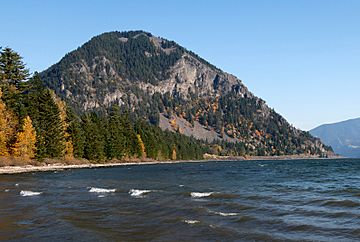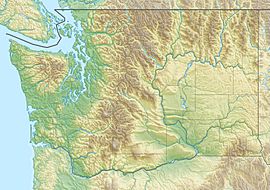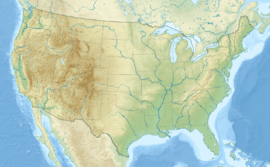Wind Mountain (Washington) facts for kids
Quick facts for kids Wind Mountain |
|
|---|---|

West aspect
|
|
| Highest point | |
| Elevation | 1,907 ft (581 m) |
| Prominence | 947 ft (289 m) |
| Isolation | 2.41 mi (3.88 km) |
| Geography | |
| Location | Skamania County, Washington, U.S. |
| Parent range | Cascade Range |
| Topo map | USGS Carson |
| Geology | |
| Age of rock | late Miocene to Pliocene |
| Mountain type | intrusive igneous |
| Type of rock | quartz diorite |
| Climbing | |
| First ascent | Native Americans |
| Easiest route | class 1 hiking trail |
Wind Mountain is a cool mountain in Washington state. It stands about 1,907 feet (581 meters) tall. You can find it in Skamania County.
About Wind Mountain
Wind Mountain is part of the Cascade Range of mountains. It is located inside the Columbia River Gorge. This area is managed by the Gifford Pinchot National Forest. The mountain is about three miles east of Carson, Washington. It is also two miles east of where the Wind River flows into the Columbia River.
Water from rain and snow on Wind Mountain flows into the Columbia River. The mountain rises very steeply. Its south side goes up 1,800 feet (549 meters) in just half a mile from the Columbia River.
You can reach the mountain by taking Washington State Route 14. There is a 1.4-mile trail called the Wind Mountain Trail that leads to the top. From the summit, you can see Greenleaf Peak and Table Mountain to the west. You can also see Dog Mountain to the east.
Native American History
Near the top of Wind Mountain is a special place called the Wind Mountain Spirit Quest. This is a sacred archeological site created by Native American young people. It dates back between 1,000 and 200 years ago.
The mountain's name was officially chosen by the U.S. Board on Geographic Names. This area is known for strong winds that blow through the Columbia River Gorge.
Native American stories say that a Great Spirit made strong whirlwinds blow around Wind Mountain. This was a punishment for people who broke a rule and showed white men how to catch salmon.
The Lewis and Clark Expedition visited this area on October 30, 1805. They saw a submerged forest at the base of the mountain. This forest was left behind by the Bonneville landslide. That landslide happened about six miles downstream.
Weather at Wind Mountain
Wind Mountain is in a marine west coast climate zone. This means it has mild, wet winters and cool, dry summers. Most of the weather systems come from the Pacific Ocean. They move east towards the Cascade Mountains.
When these weather systems reach the Cascade Mountains, the mountains force the air upward. This process is called orographic lift. As the air rises, it cools and drops its moisture as rain or snow on the mountains.
In winter, it is usually cloudy. But in summer, high-pressure systems over the Pacific Ocean often bring clear skies.
Gallery
See also
- Geology of the Pacific Northwest
- Lewis and Clark National Historic Trail









